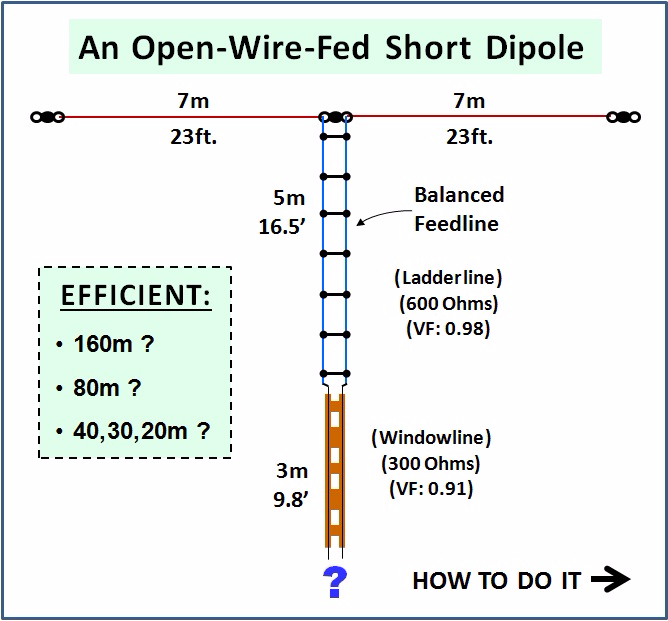Short Openwire-FED Antennas
THIS SECTION is about how to make the best of what
little available space one has for his low band antenna.
It is not about how to build the best possible antenna.
Much of the information on this and the following 3 pages is based on 4 articles written by Alfred Kluess, DF2BC, for the German magazine CQDL, as well as 3 articles written for the German magazne FUNKAMATEUR. All pictures and translated excerpts are presented here with written permission from Alfred and the DARC Verlag.
Each page concludes with a DOWNLOAD of the original article (in German language).
CONTRARY TO POPULAR BELIEF . . .
IT IS POSSIBLE TO BUILD A FAIRLY EFFECTIVE
SHORT "ANTENNA SYSTEM"
FOR THE LOW BANDS (160/80/40m)*
*See comments from L.B. Cebik on this topic below.
REASON: CONTRARY TO POPULAR BELIEF, SHORT ANTENNAS ARE NOT THEMSELVES INEFFICIENT. THEY ARE JUST A FRACTION OF A dB WEAKER THAN FULL SIZE.*
IN PRACTICE: SHORT ANTENNA SYSTEMS ARE INDEED INEFFICIENT.
REASON: THE METHOD USED TO MATCH THEM AND/OR THE FEEDLINE HAVE SIGNIFICANT LOSS, CAUSING THE OVERALL SYSTEM TO BE INEFFICIENT.
*See comments from L.B. Cebik on this topic below.
WARNING ABOUT THE WARNING
The "ARRL HANDBOOK" and "ARRL ANTENNA BOOK" both warn people to NEVER attempt to use a half wavelength dipole on half it's resonant frequency.
In other words, do NOT attempt to use a resonant 40m coax-fed dipole on 80m.
IN GENERAL THIS IS A VALID WARNING; BUT THERE CAN BE EXCEPTIONS!
Unless you understand the problems short antennas have
with high voltage and high current,
you should assume the ARRL warning is correct.
Most ham radio operators in the world do not have and never will have room for a full size 160m resonant half wavelength dipole. In fact most do not even have room for an 80m resonant dipole.
THE INFORMATION ON THIS AND THE FOLLOWING PAGES
IS FOR THOSE HAM RADIO OPERATORS WHO DO NOT HAVE
ENOUGH SPACE FOR FULL SIZE ANTENNAS
It is NOT POSSIBLE to buy a commercial antenna tuner (matchbox), past or present, that will efficiently match the antenna I will describe on the next 3 pages on 160 and 80m. Some (but just a few) can do this on 40m - but not on the lower bands.
On the next three pages, we will focus on efficient matching systems for "THIS" antenna:
Note: the brown Window-Line shown above is not required in order for the antenna to work. It's optional.
It is only shown as an exaple of how some people swith to Window-Line for running inside of the house.
EFFICIENT COMPARED TO WHAT?
- Compared to a Full Size dipole, it is a lousy antenna.
- Compared to a mobile whip mounted in the back yard with a few radials, it is a great antenna.
- Compared to a 43 ft. vertical matched with a matchbox in the shack, it is a great antenna.
- Compared to a 43 ft. vertical, matched at its base and with 30 radials, it depends on whether you are trying to work NVIS or DX.
- IS THE GLASS HALF EMPTY OR HALF FULL?
L.B. CEBIK, W4RNL (SK) on Short Antenna Efficiency:
LOSSES DUE TO SHORTENING OF THE ANTENNA:
(Excerpt) Part 3: Planes in Space
[snip] A hatted dipole (or monopole) 20% of full size, relative to a full size dipole, loses only 0.55 dB of gain--or about 1/10 of an S-unit.
[END]
DISCUSSION:
The quote above applies ONLY to the antenna and its ability to radiate RF energy.
It does not take into consideration transmission line losses or matching losses.
If that was the only loss, 1/10 of an S-Unit, then this would be a fantastic antenna.
If we match the transmission line to the antenna at the feedpoint, the transmission line losses will be negligible on the low bands. But this is impractical.
Unfortunately matching in the shack with the help of an antenna tuner (antenna matchbox) using commercially available matchboxes always results in HIGH LOSSES, regardless of the type of transmission line used.
Even using the matchbox shown on the next page results in high losses in the transmission line when the antenna is as short as the one shown here.
For that reason, especially on 160m, every effort should be made to make the dipole as long as possible and the transmission line as short as possible
I am unaware of any automatic antenna tuner, remote or otherwise, that is capable of matching this very short antenna.
THIS IS NOT A SOLUTION FOR "PUSH-BUTTON HAMS".
IN GENERAL: Common implementations of antennas like this using commercially available components results in POOR PERFORMANCE
because the losses in matching are enormous.
THERE IS A BETTER WAY . . . as we shall see on the next page.
In order to deploy this antenna-system concept in an effecient way, you will need to FORGET EVERYTHING you ever heard, saw, or read about SWR, and learn how to tune an antenna system using an RF Ammeter.
DOWNLOAD THE ORIGINAL ARTICLE:
"Optimale Anpassung durch Antennenstrommemessung", by Alfred Kluess, DF2BC, published in DARC's CQDL Magazine, March 2011 issue, pages 189 - 191.
Optimale Anpassung durch Antennenstromme[...]
PDF-Dokument [348.0 KB]
NOTE: I am in process of translating some of this text into English. I have also created an Excel spreadsheet with Alfred's measurements. You will find these on this page:
I wish to express my gratitude to Alfred, DF2BC and to the DARC Verlag for permision to use their material on my web site.
More Info on the DARC Verlag is here: www.darcverlag.de



























